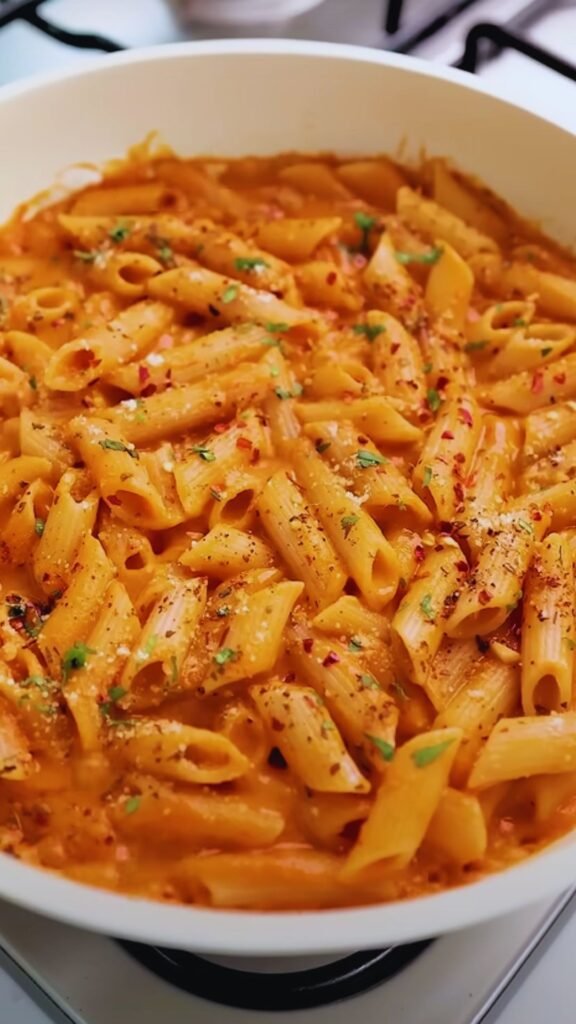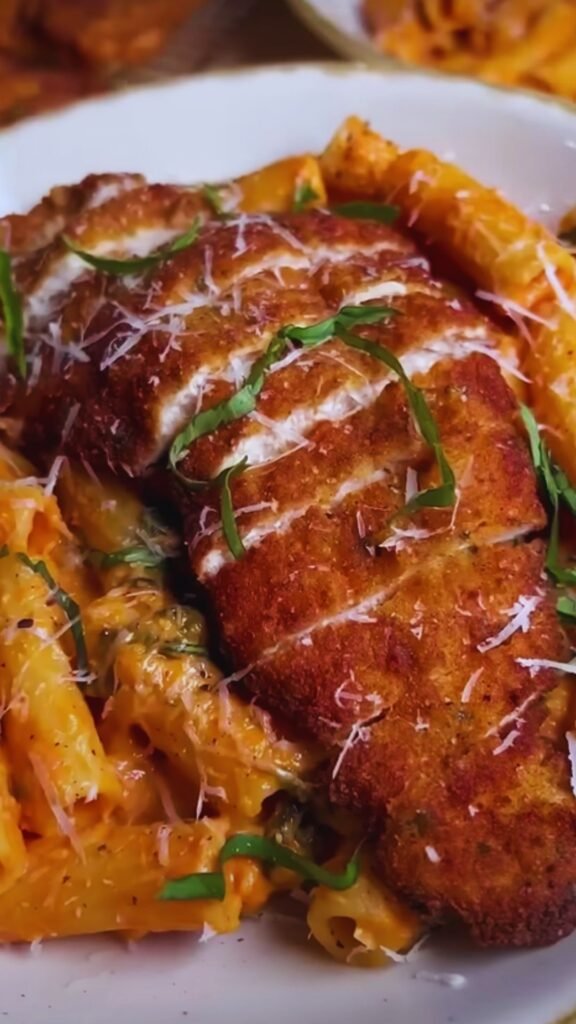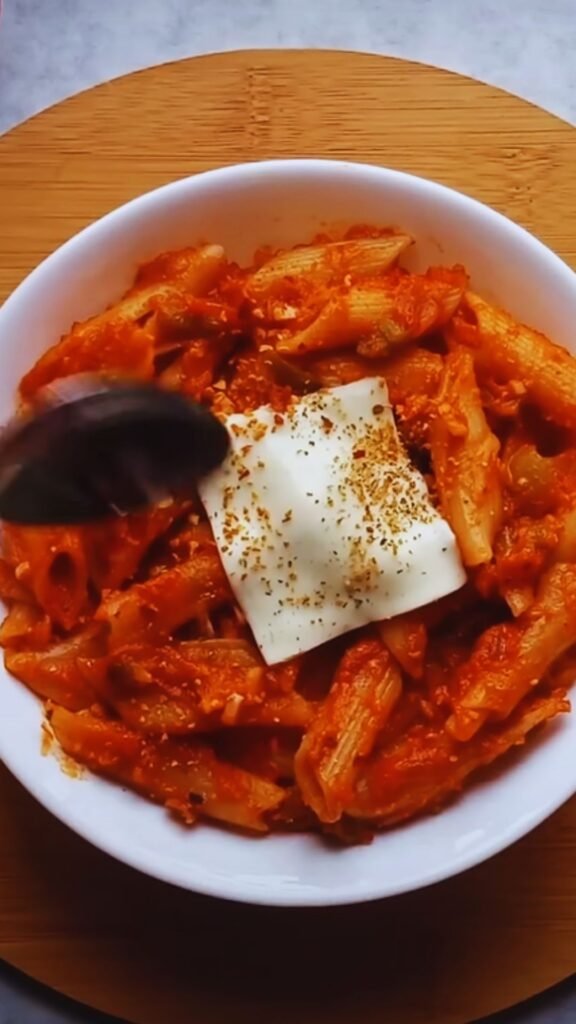Have you ever found yourself standing in your kitchen, craving something between a rich, creamy alfredo and a vibrant tomato sauce? That’s exactly where I found myself last winter when I discovered the magic of rosé sauce. Not to be confused with the pink wine (though a glass on the side never hurts!), this blush-colored sauce combines the best of both cream and tomato worlds into one velvety delight.
Today, I’m sharing my go-to simple rosé sauce recipe that has become a weekly staple in my home. This sauce is incredibly versatile, budget-friendly, and can transform ordinary pasta into a restaurant-worthy meal in less than 30 minutes.
What Exactly Is Rosé Sauce?
Rosé sauce, also known as pink sauce or vodka sauce (when vodka is added), is a creamy tomato-based sauce that achieves its signature blush color by combining tomatoes with heavy cream. The result is a sauce that’s milder and less acidic than traditional marinara, but with more depth and tanginess than a plain cream sauce.
The sauce originated in Italy, though its exact birthplace is debated between regions. Some say it was created in the 1970s in Bologna, while others credit it to chefs in Rome. Regardless of its origins, this sauce has become beloved worldwide for its silky texture and balanced flavor profile.
Why You’ll Love This Recipe
- Balance of flavors: The acidity of tomatoes meets the richness of cream
- Versatility: Works with any pasta shape and many proteins
- Quick cooking time: Ready in about 20 minutes
- Affordable ingredients: Uses pantry staples you likely already have
- Impressive results: Tastes like you spent hours in the kitchen
Essential Ingredients for a Perfect Rosé Sauce

Every great sauce starts with quality ingredients. Here’s what you’ll need to make a standout rosé sauce:
- Tomatoes: The base of our sauce
- Heavy cream: Creates the signature creaminess and pink color
- Aromatics: Garlic, shallots, and herbs bring depth
- Parmesan cheese: Adds savory umami and helps thicken the sauce
- Butter: For richness and to help emulsify
- Herbs and seasonings: To elevate the flavor profile
Let’s break down these ingredients and why they matter:
Tomatoes : I prefer using canned San Marzano tomatoes for their sweet flavor and low acidity. If you can’t find them, any high-quality canned whole tomatoes will work. In a pinch, a good tomato passata or even tomato paste diluted with water can substitute.
Heavy cream : The higher fat content (at least 36%) creates a more stable sauce that won’t separate when heated. Half-and-half can work in a pinch, but the sauce will be thinner and less luxurious.
Aromatics : Fresh garlic and shallots provide the foundation of flavor. Shallots offer a milder, sweeter flavor than onions, but you can substitute with a small yellow onion if needed.
Parmesan cheese : Always opt for freshly grated Parmigiano-Reggiano rather than pre-packaged cheese, which often contains anti-caking agents that can make your sauce grainy.
Herbs : Fresh basil is traditional, but oregano, thyme, or even a touch of rosemary can add interesting dimensions to your sauce.
Equipment You’ll Need
Before we start cooking, make sure you have these basic tools on hand:
- A large, heavy-bottomed saucepan or Dutch oven
- A wooden spoon for stirring
- A sharp knife and cutting board
- A cheese grater
- A blender or immersion blender (optional but recommended)
The Perfect Simple Rosé Sauce Recipe
Now that we’ve covered the basics, let’s dive into the actual recipe. This makes enough sauce for about 1 pound (454g) of pasta, serving 4-6 people.
Ingredients:
- 2 tbsp olive oil
- 3 tbsp unsalted butter
- 1 large shallot, finely diced (about ¼ cup)
- 4 cloves garlic, minced
- ¼ tsp red pepper flakes (optional)
- 1 (28oz) can whole San Marzano tomatoes
- 1 cup heavy cream
- ½ cup freshly grated Parmesan cheese
- 2 tbsp tomato paste (for deeper flavor)
- 1 tsp dried oregano
- ¼ cup fresh basil leaves, torn or chopped
- Salt and freshly ground black pepper, to taste
- 1 pound pasta of your choice
Instructions:
- Prepare your mise en place: Chop your shallot and garlic, measure out your ingredients, and have everything ready before you start cooking.
- Start the sauce base: In a large saucepan or Dutch oven, heat the olive oil and 2 tablespoons of butter over medium heat. Once the butter is melted, add the diced shallot and cook until translucent, about 3-4 minutes. Add the minced garlic and red pepper flakes (if using) and cook for another 30 seconds until fragrant, being careful not to burn the garlic.
- Add the tomatoes: Pour in the canned tomatoes with their juices. If using whole tomatoes, break them up with a wooden spoon or potato masher. Stir in the tomato paste and dried oregano.
- Simmer and blend: Bring the sauce to a simmer and cook for about 10 minutes, allowing the flavors to meld and the sauce to reduce slightly. If you prefer a smooth sauce (which I recommend), use an immersion blender to puree the sauce directly in the pot, or carefully transfer it to a blender, puree, and return to the pot.
- Finish with cream: Reduce the heat to medium-low and slowly stir in the heavy cream. Allow the sauce to simmer gently for 5-7 minutes, until it thickens slightly and takes on a beautiful pink color. Be careful not to let it boil, as this can cause the cream to separate.
- Add cheese and season: Stir in the grated Parmesan cheese until melted. Add salt and freshly ground black pepper to taste. Remember that the cheese adds saltiness, so add salt gradually.
- Final touch: Remove from heat and stir in the remaining tablespoon of butter and fresh basil. The butter adds a beautiful sheen and richness to the finished sauce.
- Combine with pasta: If serving with pasta, cook your pasta in well-salted water until al dente. Reserve about 1 cup of pasta water before draining. Toss the hot pasta directly into the sauce, adding a splash of pasta water if needed to reach your desired consistency.
Sauce Consistency Tips
The perfect rosé sauce should coat the back of a spoon and have a silky texture. If your sauce is:
- Too thin: Continue simmering to reduce, or add a bit more Parmesan cheese
- Too thick: Add a splash of pasta water or a little more cream
- Grainy or separated: Lower the heat immediately and whisk vigorously. In extreme cases, a splash of pasta water whisked in can help re-emulsify the sauce.
Variations to Try
One of the things I love most about rosé sauce is how adaptable it is. Here are some of my favorite variations:
Vodka Rosé Sauce
Add ¼ cup of vodka after cooking the garlic and before adding the tomatoes. Let it simmer for 2-3 minutes to cook off the alcohol while leaving behind a subtle depth of flavor that enhances the tomatoes.
Herb-Infused Rosé Sauce
Try different herb combinations like thyme and sage for fall, or basil and oregano for a more traditional Italian flavor. Add hearty herbs (rosemary, thyme) early in the cooking process and delicate herbs (basil, parsley) at the end.
Spicy Rosé Sauce
Increase the red pepper flakes to ½ teaspoon, or add a finely diced fresh chili pepper when sautéing the shallots and garlic.
Roasted Garlic Rosé Sauce
Replace regular garlic with a whole head of roasted garlic for a sweeter, more mellow flavor profile that pairs beautifully with the cream.
Protein Additions

Rosé sauce pairs wonderfully with various proteins. My favorites include:
- Shrimp: Sauté until just pink and fold into the sauce at the end
- Grilled chicken: Slice and serve on top or dice and mix into the sauce
- Italian sausage: Brown and crumble before starting the sauce, then incorporate
- Pancetta or bacon: Render and use the fat to sauté your aromatics
- Cannellini beans: For a vegetarian protein option that adds creaminess
Nutritional Information
For those keeping an eye on nutritional values, here’s a breakdown of the rosé sauce (per serving, assuming 6 servings total):
| Nutrient | Amount |
|---|---|
| Calories | 275 |
| Total Fat | 24g |
| Saturated Fat | 14g |
| Cholesterol | 72mg |
| Sodium | 295mg |
| Total Carbohydrates | 10g |
| Dietary Fiber | 2g |
| Sugars | 5g |
| Protein | 5g |
Keep in mind this is for the sauce only and doesn’t include pasta or protein additions.
Make-Ahead and Storage Tips
Rosé sauce actually improves with a bit of time, making it perfect for meal prep. Here’s how to store it:
Refrigerator Storage
Store cooled sauce in an airtight container for up to 4 days. When reheating, do so gently over low heat, stirring occasionally. You may need to add a splash of cream or water to bring it back to the proper consistency.
Freezer Storage
While cream-based sauces can sometimes separate when frozen, this rosé sauce freezes surprisingly well:
- Cool the sauce completely
- Transfer to freezer-safe containers, leaving ½ inch of headspace
- Freeze for up to 3 months
- Thaw overnight in the refrigerator before reheating gently
Storage Comparison Table
| Storage Method | Maximum Time | Best For | Notes |
|---|---|---|---|
| Refrigerator | 4 days | Near-term use | Maintains best texture and flavor |
| Freezer | 3 months | Bulk preparation | May need whisking when reheating |
| Room temperature | 2 hours | Serving only | Food safety concerns beyond this time |
Troubleshooting Common Issues
Sauce Separation
Issue: The cream separates from the tomatoes, giving the sauce a broken appearance.
Solution: Heat management is key. Keep your sauce at a gentle simmer, never a boil. If separation occurs, immediately remove from heat and whisk vigorously. Adding a splash of hot pasta water while whisking can also help re-emulsify the sauce.
Sauce Too Acidic
Issue: The tomatoes taste too acidic or tangy.
Solution: Add ¼ teaspoon of baking soda to neutralize acidity, or an extra tablespoon of butter. Make sure you’re using high-quality tomatoes, as this can make a significant difference.
Sauce Too Thin
Issue: The sauce isn’t coating pasta properly.
Solution: Continue simmering to reduce, or add more freshly grated Parmesan cheese, which acts as a natural thickener. Remember that the sauce will also thicken slightly as it cools.
Perfect Pasta Pairings

Not all pasta shapes are created equal when it comes to pairing with rosé sauce. Here are my recommendations:
- Penne: The classic choice, as the tubes catch the sauce both inside and out
- Rigatoni: Larger tubes that hold generous amounts of sauce
- Fettuccine: Flat noodles offer more surface area for the sauce to cling to
- Orecchiette: Little “ears” that cup the sauce perfectly
- Farfalle: Bow-tie pasta that both catches and showcases the pretty pink sauce
Avoid very thin pastas like angel hair, as they can get lost in this substantial sauce.
Serving Suggestions
To create a complete meal around your rosé sauce pasta:
- Sides: A simple arugula salad with lemon vinaigrette provides a perfect acidic balance to the rich sauce
- Bread: Crusty garlic bread or focaccia for sopping up extra sauce
- Vegetables: Roasted broccoli or asparagus adds color and nutrition
- Beverages: Sparkling water with lemon, or iced tea with fresh mint
Dietary Modifications
Dairy-Free Version
For a dairy-free alternative, substitute:
- Canned coconut cream for heavy cream
- Nutritional yeast for Parmesan cheese
- Olive oil for butter
The sauce will have a slightly different flavor profile but will maintain the creamy texture that makes rosé sauce special.
Lower-Calorie Version
To reduce calories:
- Use half-and-half instead of heavy cream
- Reduce butter to 1 tablespoon total
- Use less Parmesan (¼ cup instead of ½ cup)
- Bulk up with pureed cauliflower for added creaminess without the calories
Gluten-Free Considerations
The sauce itself is naturally gluten-free (always check your tomato paste to be sure). Simply pair with your favorite gluten-free pasta for a completely gluten-free meal.
Cost Analysis
One of the best things about homemade rosé sauce is how economical it is compared to restaurant versions. Here’s a breakdown of approximate costs:
| Ingredient | Approximate Cost |
|---|---|
| Canned tomatoes | $3.50 |
| Heavy cream | $2.50 |
| Parmesan cheese | $3.00 |
| Shallot and garlic | $1.00 |
| Butter and olive oil | $1.00 |
| Herbs and seasonings | $0.50 |
| Total | $11.50 |
At $11.50 for the entire batch (serving 6), that’s about $1.92 per serving for a gourmet sauce that would cost you $15-20 at a restaurant. Add in $1-2 for pasta, and you’ve got a delicious main course for under $4 per person.
Why Make Rosé Sauce at Home?
I’ve experimented with countless jarred sauces over the years, and I can tell you without hesitation that homemade rosé sauce is worth the (minimal) effort. Here’s why:
- Control: You decide exactly how creamy, tangy, or herbaceous your sauce will be
- Quality: No preservatives, stabilizers, or mystery ingredients
- Freshness: The flavor of freshly made sauce cannot be matched by jarred alternatives
- Cost-effectiveness: Significantly cheaper than pre-made or restaurant versions
- Impressive: This sauce looks and tastes like you spent hours in the kitchen
Chef’s Notes
After making this sauce dozens of times, I’ve collected a few professional tips that can elevate your rosé sauce from good to outstanding:
- Always use room temperature cream to prevent temperature shock and potential separation
- The quality of your tomatoes matters tremendously; splurge on San Marzano if you can
- Pasta water is liquid gold—the starch helps bind the sauce to the pasta
- If using wine in your sauce, make sure it’s completely reduced before adding cream
- For a brighter flavor, add a tiny squeeze of fresh lemon juice just before serving
Q&A Section
Can I make rosé sauce without heavy cream? Yes, you can substitute half-and-half or even whole milk, though the sauce will be thinner and less rich. For a dairy-free option, full-fat coconut milk works surprisingly well.
Why is my sauce separating? Separation usually occurs when the sauce gets too hot after the cream is added. Keep the heat low, avoid boiling, and whisk regularly to prevent this issue.
Can I add vodka to this recipe? Absolutely! Add ¼ cup after cooking the garlic and before adding the tomatoes. Allow it to simmer for 2-3 minutes to cook off the alcohol while leaving behind a subtle complexity.
How long does rosé sauce keep in the refrigerator? Properly stored in an airtight container, homemade rosé sauce will keep for 3-4 days in the refrigerator.
What’s the difference between rosé sauce and vodka sauce? Rosé sauce is simply a cream and tomato sauce, while vodka sauce includes vodka for additional flavor complexity. Many people use the terms interchangeably.
Can I use fresh tomatoes instead of canned? Yes, but you’ll need to blanch, peel, and seed about 2 pounds of fresh tomatoes. This adds significant prep time, which is why many chefs prefer high-quality canned tomatoes for sauce making.
Is rosé sauce healthy? While delicious, traditional rosé sauce is relatively high in fat and calories due to the heavy cream and cheese. See the “Dietary Modifications” section for healthier alternatives.
What can I do if my sauce is too acidic? Add a pinch of baking soda (it neutralizes acid) or a pat of butter, which can help mellow the acidity. Also, make sure you’re using good quality tomatoes, as they tend to be naturally less acidic.
Final Thoughts
A simple rosé sauce is one of those culinary treasures that delivers maximum flavor with minimal effort. Once you master this basic recipe, you’ll find yourself turning to it again and again, customizing it to suit your taste or the occasion.
What I love most about this sauce is its versatility—it’s equally at home on a busy weeknight dinner table or at an elegant dinner party. The creamy texture, balanced flavor, and beautiful blush color make any dish feel special, even when it took you less than 30 minutes to prepare.
I hope this recipe becomes a staple in your kitchen as it has in mine. Remember, cooking is about experimentation and finding what works for you. Don’t be afraid to adjust the proportions or try different add-ins to make this sauce uniquely yours.
Happy cooking!



